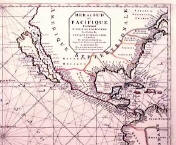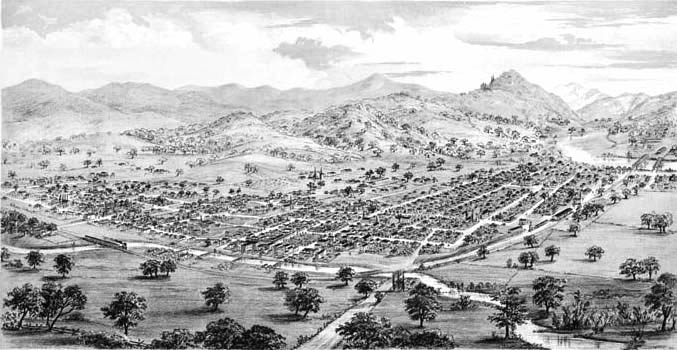|
|
|
|
0000-1880 |
|
Pomo villages in Healdsburg area from prehistory to late 1800s |
|
1579 |
|
Sir Francis Drake sailed on the ‘Golden Hind” following the
coast south from what is now Oregon ‘42 latitude.
He landed somewhere in California on June 17th. There has been speculation
for over 400 years about the exact location of Drake's landing site. The
principal candidates include Bodega Bay, Drake's Bay, Bolinas Bay. He names the coast ‘New Abion” and
lays English
claim to west coast of America. |
|
1602 |
|
Sebastian Vizcaino-Aguilar explores the west coast as far north as Cape
Mendocino. He names the Rio de Sebastian (now called the Russian River). |
|
1700 |
|
|
|
1747 |
|
California was believed to be an island
long after "discovery". Father Kino walked there from the "mainland" in 1698
disproving the concept. In spite of this, only after Father Consag sailed
completely around the Gulf of California in 1747, did King Ferdinand of
Spain issued a Royal decree stating "California is not an Island!"  Map
(detail) by P. Mortier, Amsterdam 1693. -- private collection.
Map
(detail) by P. Mortier, Amsterdam 1693. -- private collection. |
 |
|
1769 |
|
Gaspar de Portola Expedition for Spain encounters natives living in San
Francisco Bay area. First sighting of San Francisco Bay by Europeans.
|
|
1769-1823 |
|
The Spanish build twenty-one missions,
two pueblos, and four presidios, from Mission San Diego to Mission Sonoma, all
established along what was called El Camino Real "The King's Highway".
(8)
|
|
1775
|
|
American Revolution
begins. Ensign Juan Francisco de la Bodega
y Cuarra entered and named Bodega Bay and Tomales Bay. |
|
1776 |
|
Spanish begin building Mission San Francisco de Assisi (Mission Dolores) |
|
1776-1777 |
|
Spanish soldiers build the Presidio in San Francisco |
|
1788 |
|
United States adopts the Constitution |
|
|
|
|
|
1812 |
|
Fort Ross settlement
established for the Russian-American Company by Ivan A. Kuskov He sets
up port facilities in Bodega Bay and begins to establish camp in Russian Gulch
area. Explores the Russian River, which he called the Slavianka River.(1)
(2)
June 19: U.S. President Madison declares
war or Great Britain. War of 1812. |
|
1814 |
|
August 24: British burn Washington.
Sept. 13-14: Siege of Fort McHenry (Battle of Baltimore) - "Star Spangled
Banner" is inspired by British mortars and rockets. December 24: Treaty of
Ghent signed to end war. |
|
1822 |
|
California becomes Mexican territory at the end of their War of
Independence. |
|
1823 |
|
Franciscan mission San Francisco Solano established at what will become the
town of Sonoma. |
1821-1846 |
|
Mexico rules over California with a series of 12 governors. The governors
reduced the Spanish missions to mere parishes and granted the acres owned by
the priests to Mexican nobles. Between 1822 and 1846, more than 800 California land grants were made to
individuals by the Mexican government. In what would become Sonoma County, 26 land grants were issued,
the largest was General Vallejo's 66,600 acre Petaluma rancho.
(3) |
|
1833 |
|
Garrison established at former Mission San Francisco Solano by 25 year old
General Mariano Vallejo. |
|
1834 |
|
Mexican government seizes all Mission lands
|
|
1835 |
|
Sonoma Pueblo built |
|
1836 |
|
- Construction of General Vallejo’s massive Petaluma adobe began in April.
|
| |
|
- Russian E.
L. Chernykh establishes Rancho near the Russian River downstream from
Healdsburg
in the area
now called Freestone and Graton. |
|
1838 |
|
Severe earthquake occurs along the San Andreas fault |
|
1840 |
|
-
Cyrus Alexander arrives in what we now call Alexander Valley
(4)
- Boston: Richard Henry Dana publishes
Two Years Before the Mast
- The first covered wagon
train arrives in California |
|
1841 |
|
- Chernykh in a report to the Russian Imperial Society for Rural Economy,
writes: "Local grapes make good wine, but in small quantities and does not
keep well." (1)
- The Russians sell Fort Ross to John Sutter in December.
Russian scientist Voznesensky and Agronomist Chernyk climb Mt. ST. Helena on
their way to Fort Sutter to negotiate the sale.
(2)
 |
|
Fort Ross
-
Watercolor
by Il'ia Voznesenky, 1841

|
|
|
1841-1844 |
|
Mexico grants 48,800 acres, including the Healdsburg area, to
Henry Delano Fitch.
Named Rancho Sotoyome |
|
1842 |
|
England: Darwin composes abstract of theory of evolution |
|
1843 |
|
- German Pina takes possession of "four square leagues of land",
a Mexican Land Grant. Named Rancho Tzabaco, it occupied most of what we now call Dry Creek Valley
(4)
- John Fremont establishes
California Trail branch from the Oregon Trail
(7)
- London: Charles Dickens
publishes A Christmas Carol |
|
1845 |
|
July 4. Concord, Mass.: Henry David Thoreau moves into Walden
Pond home |
|
1846 |
|
- General Vallejo's Petaluma Adobe near completion
- Jan. 13. Texas: U.S.
begins war with Mexico
- June 19 Hoboken, N.J.:
first official baseball game |
|
1847 |
|
- Cyrus Alexander establishes ranch from a share of Rancho Sotoyome
- July 24. Utah: Mormons
found Salt Lake City
- U.S. captures Mexico
City |
1848
 |
|
- Sutter discovers gold in California
- California is ceded to the United States
by Mexico in Treaty of Guadalupe-Hidalgo
- Stephen Foster writes
song, "Oh, Susanna!"
- Europe: Marx and Engels
publish
Communist Manifesto |
|
1849 |
|
- The California Gold Rush, Roderick Matheson seeks his fortune.
- Captain Fitch dies
- May 14. Concord, Mass.:
Thoreau publishes "On Civil Disobedience" |
|
1850 |
|
- Sept. 9. California
admitted as 31st state
- Levi Strauss & Co.
founded in San Francisco
- The Heald brothers move to Russian River area and help William March build
a flour and lumber mill at the Upper Falls of Mill Creek. |
|
1851 |
|
Harmon Heald builds a small squatter's cabin at the side of a dirt road, now
known as the 300 block of Healdsburg Avenue |
|
1852 |
|
- Matheson is Comptroller of the City of San Francisco.
-
June 5. U.S.: Harriet
Beecher Stowe publishes
Uncle Tom's Cabin
- Healdsburg population: a few squatter families and about 100 native
Americans |
|
1853 |
|
Stephen Foster writes song "My Old Kentucky Home"
|
|
1855 |
|
Walt Whitman publishes Leaves of Grass
|
|
1856 |
|
-
Matheson and his family move to Healdsburg.
- Harmon Heald, squatter, purchases 100 acres west of current downtown
Healdsburg. In July and December Heald buys 65 acres from his brothers-in-law,
(originally purchased from widow Josefa Fitch's land
auctions earlier in the year)
(4) |
1857 |
|
-
Heald recorded the Town Plat map on March 5, 1857.
- Slavery protected by
U.S. Supreme Court's
Dred Scott decision
- Alexander Skaggs illegally settles in
the western end of what is now known as Dry Creek Valley
- Healdsburg population 300 |
|
1858 |
|
- Harmon Heald dies in December
- First transatlantic
cable laid |
|
1860 |
|
Pony Express begins, St.
Louis to California |
|
1861 |
|
- Feb. 9..Richmond:
Confederate States of America formed.
- April 12..Charleston,
S.C.: Civil War begins.
-
July 21, 1861. Matheson leads the
1st California Regiment at the First
Battle of Bull Run, Manassas, Virginia
- Healdsburg population over 500 |
|
1863 |
|
- Jan. 1..U.S.:
Emancipation Proclamation takes effect
- Nov. 19..Gettysburg,
Pa.: Lincoln addresses commemoration |
|
1865 |
|
- April 9....Appomattox,
Va.: Gen. Robert E. Lee surrenders to Gen. Ulysses S. Grant
- England: Lewis Carroll
publishes
Alice in Wonderland |
|
1869
|
|
Louisa May Alcott
publishes
Little Women |
|
1870 |
|
Paris: Jules Verne
publishes
Twenty Thousand Leagues
Under the Sea |
|
1871 |
|
- Opening day of the new San Francisco and North Pacific Railway in
Healdsburg. (5)
- Healdsburg population 1,750
|
|
1876 |
|
- Mark Twain publishes
Tom Sawyer
- Mar. 10.. Alexander
Graham Bell first demonstrates telephone
- June 25...Battle of
Little Big Horn (Custer's Last Stand) |
|
|
|
|
 |
|
Healdsburg 1876
 --image from Library of Congress, Drawn by E. S. Glover, published
in 1876 by Jordan Bros. San Francisco.
--image from Library of Congress, Drawn by E. S. Glover, published
in 1876 by Jordan Bros. San Francisco. |
|
|
1877 |
|
Black Bart held up a stage 2 1/2 miles south of Fort Ross on Meyers Grade
Road. |
|
1879 |
|
Electric light bulb
perfected by Edison |
|
1880 |
|
Petaluma Adobe falls into disrepair |
|
1882 |
|
Healdsburg College founded by Seventh-Day Adventists |
|
1884 |
|
- Healdsburg had seven churches, one bank, and two newspapers
- N.Y.: George Eastman
invents first transparent photographic film
- Healdsburg population
2,500 |
|
1885 |
|
Mark Twain publishes
Huckleberry Finn |
|
1886 |
|
New Healdsburg City Hall opened. SF & NPR renamed Northwestern Pacific
Railroad at turn of century.
(5) |
|
1887 |
|
Life and adventures of Col. L. A. Norton
published. Norton played a key
role in the Healdsburg Squatter's Wars of the 1850's. |
|
1906 |
|
April 18. San Francisco earthquake. Collapse
of the three story Odd Fellow's Hall (currently the Brant Building at Matheson
and Healdsburg Ave.) and the two story Gobbi building at 310 Center St. in
Healdsburg |
1914 |
|
-
World War I begins. NWP completes rail line
through Eel River Canyon with service to Eureka.
- Healdsburg population
3,500. |
|
1917 |
|
Healdsburg "rated as the fifth in California in per capita wealth"
(5)
|
|
1919 |
|
United States passes the Eighteenth
Amendment (Prohibition) |
|
1928
|
|
NWP opens new Railroad Station in Healdsburg. Gas-electric passenger rail car
service from Healdsburg to Sausalito established |
|
1929 |
|
Stock market crash. Four passenger trains per day on NWP Railroad.
|
|
1933 |
|
Prohibition ended. Hops industry destroyed, Wine industry severely damaged,
many Healdsburg area wineries close (6) |
|
1941 |
|
- Japan bombs Pearl Harbor; America declares
war.
- Healdsburg population 4,000 |
|
1942-1945
|
|
WW II - An estimated 700 people from Healdsburg saw military service during
WW II |
|
1950 |
|
Korean War begins |
|
1958 |
|
The last regularly scheduled passenger train stopped at Healdsburg station
(5) |
|
1960 |
|
November, Highway 101 Healdsburg Freeway bypass dedicated |
|
1996 |
|
- Urban Growth Boundary established for Healdsburg
(4)
- Healdsburg population 10,000 |
|
2000 |
|
- Healdsburg population 11,000
- Growth Management Ordinance enacted
regulating number of new houses per year |
|
2003 |
|
- Healdsburg population 11,500
|
|
|
|
| |
|
Healdsburg Museum and Historical Society
Sonoma County Historical Society
The
California State Park Service - Fort Ross State Historic Park
Present Day Fort Ross
(360 degree Panorama)
The California State Military Museum
|